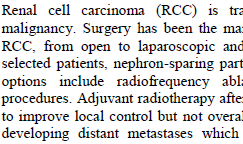Renal Cell Carcinomas: Radiotherapy, Clinical Application, Radio-Sensitivity and Dose-Response
Keywords:
Radiotherapy, Application, Renal Cell Carcinomas, Dose-ResponseAbstract
Renal cell carcinoma (RCC) is traditionally considered to be a ‘‘radioresistant’’ malignancy. Surgery has been the mainstay of treatment in the management of primary RCC, from open to laparoscopic and more recently robotic radical nephrectomy. For selected patients, nephron-sparing partial nephrectomy is performed. Other local therapy options include radiofrequency ablation (RFA), cryoablation, and other ablative procedures. Adjuvant radiotherapy after nephrectomy in high-risk patients has been shown to improve local control but not overall survival. These patients have high propensity for developing distant metastases which may explain the lack of survival benefits with adjuvant radiotherapy. In addition, it is also very difficult to deliver high dose radiation with conventional technique because of the radiation tolerance of normal tissues, especially the small bowels. With the approved use of various effective targeted agents, patients with high risk and metastatic RCC are now surviving longer and the role of local therapy for both primary and metastatic RCC has also become more important. Stereotactic radiosurgery (SRS) has been shown to be very effective in the management of RCC brain metastases. Extracranially, conventional radiotherapy has played an important role in the palliation of meta static RCC associated symptoms such as pain. Stereotactic body radiation therapy (SBRT), a continuum of technological advances in SRS from intracranial to extracranial application, has now evolved to show promise in the local management primary RCC, local recurrence, and various meta static sites. In summary, due to advancements in technology that allow for the precise delivery of high-dose RT targeted at the tumor, metastasis-directed RT in mRCC has emerged as a strategy to either mitigate or delay systemic treatment, or to enhance survival when used in conjunction with TKIs and ICBs. While this review primarily discussed SABR as the form of RT for patients with mRCC, it is important to note that not only SABR, but also various RT dose-fractionation regimens delivering higher (ablative) doses, can be utilized for this purpose. In this context, the treating radiation oncologist must strike a careful balance between the tumor control probability and the normal tissue complication probability. Future studies should aim to establish the optimal RT dose fractionation and the best sequence for combining it with systemic treatments. Factors such as the probability of local and overall disease control, antitumor immunity, and the risk of toxicity should all be considered in a comprehensive manner.
Downloads
References
Motzer R, Alekseev B, Rha SY, Porta C, Eto M, Powles T, et al. Lenvatinib plus pembrolizumab or everolimus for advanced renal cell carcinoma. N Engl J Med 2021;384:1289- 300.
Deschavanne PJ, Fertil B. A review of human cell radiosensitivity in vitro. Int J Radiat Oncol Biol Phys 1996;34:251-66.
Shaikh T, Handorf EA, Murphy CT, Kutikov A, Uzzo RG, Hallman M, et al. Contemporary trends in the utilization of radiotherapy in patients with renal cell carcinoma. Urology 2015;86:1165-73.
Rathmell WK, Rumble RB, Van Veldhuizen PJ, Al-Ahmadie H, Emamekhoo H, Hauke RJ, et al. Management of metastatic clear cell renal cell carcinoma: ASCO guideline. J Clin Oncol 2022;40:2957-95.
Ljungberg B, Albiges L, Abu-Ghanem Y, Bensalah K, Dabestani S, Fernández-Pello S, et al. European Association of Urology guidelines on renal cell carcinoma: the 2019 update. Eur Urol 2019;75:799-810.
National Comprehensive Cancer Network. Clinical practice guidelines on oncology. Kidney cancer version 1.2024 [Internet]. Fort Washington (PA): National Comprehensive Cancer Network; [cited 2023 Sep 26].
DiBiase SJ, Valicenti RK, Schultz D, Xie Y, Gomella LG, Corn BW. Palliative irradiation for focally symptomatic metastatic renal cell carcinoma: support for dose escalation based on a biological model. J Urol 1997;158(3 Pt 1):746-9.
Tan MH, Rogers CG, Cooper JT, Ditlev JA, Maatman TJ, Yang X, et al. Gene expression profiling of renal cell carcinoma. Clin Cancer Res 2004;10(18 Pt 2):6315S-6321S.
Choi WH, Cho J. Evolving clinical cancer radiotherapy: concerns regarding normal tissue protection and quality assurance. J Korean Med Sci 2016;31 Suppl 1(Suppl 1):S75-87.
Ning S, Trisler K, Wessels BW, Knox SJ. Radiobiologic studies of radioimmunotherapy and external beam radiotherapy in vitro and in vivo in human renal cell carcinoma xenografts. Cancer 1997;80(12 Suppl):2519-28.
Fuks Z, Kolesnick R. Engaging the vascular component of the tumor response. Cancer Cell 2005;8:89-91. 18. Staehler M, Bader M, Schlenker B, Casuscelli J, Karl A, Roosen A, et al. Single fraction radiosurgery for the treatment of renal tumors. J Urol 2015;193:771-5.
Siva S, Louie AV, Warner A, Muacevic A, Gandhidasan S, Ponsky L, et al. Pooled analysis of stereotactic ablative radiotherapy for primary renal cell carcinoma: a report from the International Radiosurgery Oncology Consortium for Kidney (IROCK). Cancer 2018;124:934-42.
Correa RJM, Louie AV, Zaorsky NG, Lehrer EJ, Ellis R, Ponsky L, et al. The emerging role of stereotactic ablative radiotherapy for primary renal cell carcinoma: a systematic review and meta-analysis. Eur Urol Focus 2019;5:958-69.
Wersäll PJ, Blomgren H, Lax I, Kälkner KM, Linder C, Lundell G, et al. Extracranial stereotactic radiotherapy for primary and metastatic renal cell carcinoma. Radiother Oncol 2005;77:88-95.
Zelefsky MJ, Greco C, Motzer R, Magsanoc JM, Pei X, Lovelock M, et al. Tumor control outcomes after hypofractionated and single-dose stereotactic image-guided intensity-modulated radiotherapy for extracranial metastases from renal cell carcinoma. Int J Radiat Oncol Biol Phys 2012;82: 1744-8.
Thibault I, Atenafu EG, Chang E, Chao S, Ameen AO, Zhou S, et al. Risk of vertebral compression fracture specific to osteolytic renal cell carcinoma spinal metastases after stereotactic body radiotherapy: a multi-institutional study. J Radiosurg SBRT 2015;3:297-305.
Luyendijk M, Visser O, Blommestein HM, de Hingh IHJT, Hoebers FJP, Jager A, et al. Changes in survival in de novo metastatic cancer in an era of new medicines. J Natl Cancer Inst 2023;115:628-35.
Beckham TH, Yang TJ, Gomez D, Tsai CJ. Metastasis-directed therapy for oligometastasis and beyond. Br J Cancer 2021;124:136-41.
Hellman S, Weichselbaum RR. Oligometastases. J Clin Oncol 1995;13:8-10. 27. Guckenberger M, Lievens Y, Bouma AB, Collette L, Dekker A, deSouza NM, et al. Characterisation and classification of oligometastatic disease: a European Society for Radiotherapy and Oncology and European Organisation for Research and Treatment of Cancer consensus recommendation. Lancet Oncol 2020;21:e18-28.
Palma DA, Olson R, Harrow S, Gaede S, Louie AV, Haasbeek C, et al. Stereotactic ablative radiotherapy versus standard of care palliative treatment in patients with oligometastatic cancers (SABR-COMET): a randomised, phase 2, open-label trial. Lancet 2019;393:2051-8.
Palma DA, Olson R, Harrow S, Gaede S, Louie AV, Haasbeek C, et al. Stereotactic ablative radiotherapy for the comprehensive treatment of oligometastatic cancers: long-term results of the SABR-COMET phase II randomized trial. J Clin Oncol 2020;38:2830-8.
Olson R, Mathews L, Liu M, Schellenberg D, Mou B, Berrang T, et al. Stereotactic ablative radiotherapy for the comprehensive treatment of 1-3 Oligometastatic tumors (SABRCOMET-3): study protocol for a randomized phase III trial. BMC Cancer 2020;20:380.
Palma DA, Olson R, Harrow S, Correa RJM, Schneiders F, Haasbeek CJA, et al. Stereotactic ablative radiotherapy for the comprehensive treatment of 4-10 oligometastatic tumors (SABR-COMET-10): study protocol for a randomized phase III trial. BMC Cancer 2019;19:816
Beitler JJ, Makara D, Silverman P et al (2004) Definitive, high dose-per-fraction, conformal, stereotactic external radiation for renal cell carcinoma. Am J Clin Oncol 27:646–648
Bhatt RS, Landis DM, Zimmer M, Torregrossa J, Chen S, Sukhatme VP, Iliopoulos O, Balk S, Bubley GJ (2008) Hypoxia-inducible factor-2alpha: effect on radiation sensi tivity and differential regulation by an mTOR inhibitor. BJU Int 102:358–363
Culine S, Bekradda M, Kramar A et al (1998) Prognostic factors for survival in patients with brain metastases from renal cell carcinoma. Cancer 83:2548–2553
Deschavanne PJ, Fertil B (1996) A review of human cell radiosensitivity in vitro. Int J Radiat Oncol Biol Phys 34:251–266
DiBiase SJ, Valicenti RK, Schultz D, Xie Y, Gomella LG, Corn BW (1997) Palliative irradiation for focally symptomatic metastatic renal cell carcinoma: Support for dose escalation based on a biological model. J Urol 158:746–749
Fowler JF (1989) The linear-quadratic formula and progress in fractionated radiotherapy. Br J Radiol 62:679–694 Garcia-Barros M, Paris F, Cordon-Cardo C, Lyden D, Rafii S, Haimovitz-Friedman A, Fuks Z, Kolesnick R (2003) Tumor response to radiotherapy regulated by endothelial cell apoptosis. Science 300:1155–1159
Gerszten PC, Burton SA, Ozhasoglu C, Vogel WJ, Welch WC, Baar J, Friedland DM (2005) Stereotactic radiosurgery for spinal metastases from renal cell carcinoma. J Neurosurg 3:288–295
Hoshi S, Jokura H, Nakamura H, Shintaku I, Ohyama C, Satoh M, Saito S, Fukuzaki A, Orikasa S, Yoshimoto T (2002) Gamma-knife radiosurgery for brain metastasis of renal cell carcinoma: results in 42 patients. Int J Urol 9:618–625
Hui Z, Tretiakova M, Zhang Z, Li Y, Wang X, Zhu JX, Gao Y, Mai W, Furge K, Qian CN et al (2009) Radiosensitization by inhibiting stat1 in renal cell carcinoma. Int J Radiat Oncol Biol Phys 73:288–295
Jhaveri P, Teh BS, Paulino AC, Blanco AI, Lo SS, Butler EB, Amato RJ (2012) A dose-response relationship for time to bone pain resolution after stereotactic body radiotherapy for renal cell carcinoma metastases. Acta Oncol 51:584–588
Juusela H, Malmio K, Alfthan O, Oravisto KJ (1977) Preop erative irradiation in the treatment of renal adenocarcinoma. Scand J Urol Nephrol 11:277–281 Kaplan ID, Redrosa I, Martin C et al (2010) Results of a phase I dose escalation study of stereotactic radiosurgery for primary renal tumors. Intl J Radiat Oncol Biol Phys 2010(78):S191
Karam JA, Wood CG (2011) The role of surgery in advanced renal cell carcinoma: cytoreductive nephrectomy and met atarsectomy. Hematol Oncol Clin North Am 25:753–764
Kasibhatla M, Steinberg P, Meyer J, Ernstoff MS, George DJ (2007) Radiation therapy and sorafenib: clinical data and rationale for the combination in metastatic renal cell carcinoma. Clin GU Cancer 5:291–294

Downloads
Published
How to Cite
Issue
Section
License

This work is licensed under a Creative Commons Attribution 4.0 International License.
Current Clinical and Medical Education













